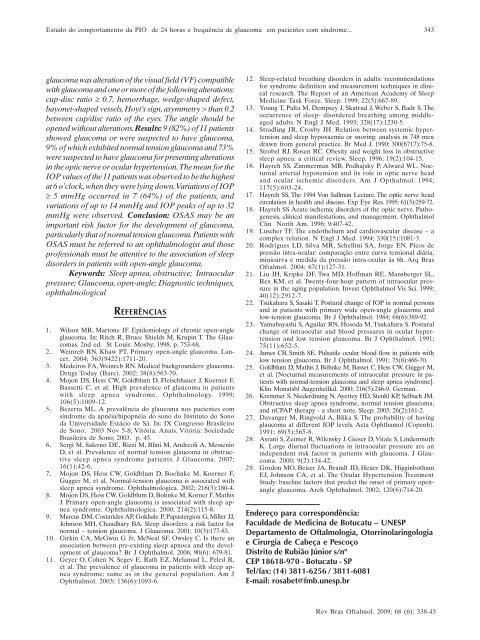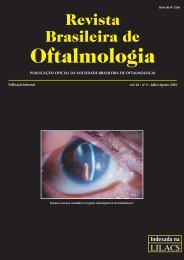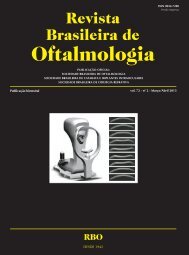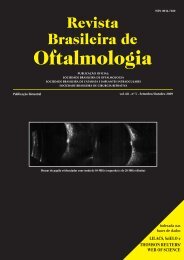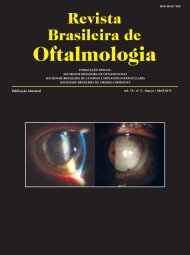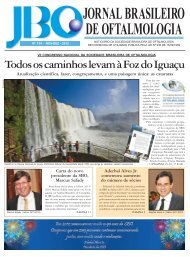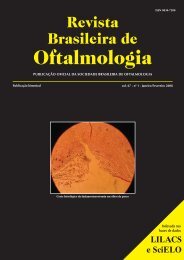Nov-Dez - Sociedade Brasileira de Oftalmologia
Nov-Dez - Sociedade Brasileira de Oftalmologia
Nov-Dez - Sociedade Brasileira de Oftalmologia
- No tags were found...
You also want an ePaper? Increase the reach of your titles
YUMPU automatically turns print PDFs into web optimized ePapers that Google loves.
Estudo do comportamento da PIO <strong>de</strong> 24 horas e frequência <strong>de</strong> glaucoma em pacientes com síndrome...343glaucoma was alteration of the visual field (VF) compatiblewith glaucoma and one or more of the following alterations:cup-disc ratio ≥ 0.7, hemorrhage, wedge-shaped <strong>de</strong>fect,bayonet-shaped vessels, Hoyt’s sign, asymmetry > than 0.2between cup/disc ratio of the eyes. The angle should beopened without alterations. Results: 9 (82%) of 11 patientsshowed glaucoma or were suspected to have glaucoma,9% of which exhibited normal tension glaucoma and 73%were suspected to have glaucoma for presenting alterationsin the optic nerve or ocular hypertension. The mean for theIOP values of the 11 patients was observed to be the highestat 6 o’clock, when they were lying down. Variations of IOP≥ 5 mmHg occurred in 7 (64%) of the patients, andvariations of up to 14 mmHg and IOP peaks of up to 32mmHg were observed. Conclusion: OSAS may be animportant risk factor for the <strong>de</strong>velopment of glaucoma,particularly that of normal tension glaucoma. Patients withOSAS must be referred to an ophthalmologist and thoseprofessionals must be attentive to the association of sleepdisor<strong>de</strong>rs in patients with open-angle glaucoma.Keywords: Sleep apnea, obstructive; Intraocularpressure; Glaucoma, open-angle; Diagnostic techniques,ophthalmologicalREFERÊNCIAS1. Wilson MR, Martone JF. Epi<strong>de</strong>miology of chronic open-angleglaucoma. In: Ritch R, Bruce Shields M, Krupin T. The Glaucomas.2nd ed. St Louis: Mosby; 1998. p. 753-68.2. Weinreb RN, Khaw PT. Primary open-angle glaucoma. Lancet.2004; 363(9422):1711-20.3. Me<strong>de</strong>iros FA, Weinreb RN. Medical backgroun<strong>de</strong>rs: glaucoma.Drugs Today (Barc). 2002; 38(8):563-70.4. Mojon DS, Hess CW, Goldblum D, Fleischhauer J, Koerner F,Bassetti C, et al. High prevalence of glaucoma in patientswith sleep apnea syndrome. Ophthalmology. 1999;106(5):1009-12.5. Bezerra ML. A prevalência do glaucoma nos pacientes comsíndrome da apnéia/hipopnéia do sono do Instituto do Sonoda Universida<strong>de</strong> Estácio <strong>de</strong> Sá. In: IX Congresso Brasileiro<strong>de</strong> Sono; 2003 <strong>Nov</strong> 5-8; Vitória. Anais. Vitória: <strong>Socieda<strong>de</strong></strong><strong>Brasileira</strong> <strong>de</strong> Sono; 2003. p. 45.6. Sergi M, Salerno DE, Rizzi M, Blini M, Andreoli A, MessenioD, et al. Prevalence of normal tension glaucoma in obstructivesleep apnea syndrome patients. J Glaucoma. 2007;16(1):42-6.7. Mojon DS, Hess CW, Goldblum D, Boehnke M, Koerner F,Gugger M, et al. Normal-tension glaucoma is associated withsleep apnea syndrome. Ophthalmologica. 2002; 216(3):180-4.8. Mojon DS, Hess CW, Goldblum D, Bohnke M, Korner F, MathisJ. Primary open-angle glaucoma is associated with sleep apneasyndrome. Ophthalmologica. 2000; 214(2):115-8.9. Marcus DM, Costari<strong>de</strong>s AP, Gokhale P, Papastergiou G, Miller JJ,Johnson MH, Chaudhary BA. Sleep disor<strong>de</strong>rs: a risk factor fornormal – tension glaucoma. J Glaucoma. 2001; 10(3):177-83.10. Girkin CA, McGwin G Jr, McNeal SF, Owsley C. Is there anassociation between pre-existing sleep apnoea and the <strong>de</strong>velopmentof glaucoma? Br J Ophthalmol. 2006; 90(6): 679-81.11. Geyer O, Cohen N, Segev E, Rath EZ, Melamud L, Peled R,et al. The prevalence of glaucoma in patients with sleep apneasyndrome: same as in the general population. Am JOphthalmol. 2003; 136(6):1093-6.12. Sleep-related breathing disor<strong>de</strong>rs in adults: recommendationsfor syndrome <strong>de</strong>finition and measurement techniques in clinicalresearch. The Report of an American Aca<strong>de</strong>my of SleepMedicine Task Force. Sleep. 1999; 22(5):667-89.13. Young T, Palta M, Dempsey J, Skatrud J, Weber S, Badr S. Theoccurrence of sleep- disor<strong>de</strong>red breathing among middleagedadults. N Engl J Med. 1993; 328(17):1230-5.14. Stradling JR, Crosby JH. Relation between systemic hypertensionand sleep hypoxaemia or snoring: analysis in 748 mendrawn from general practice. Br Med J. 1990; 300(6717):75-8.15. Strobel RJ, Rosen RC. Obesity and weight loss in obstructivesleep apnea: a critical review. Sleep. 1996; 19(2):104-15.16. Hayreh SS, Zimmerman MB, Podhajsky P, Alward WL. Nocturnalarterial hypotension and its role in optic nerve headand ocular ischemic disor<strong>de</strong>rs. Am J Opthalmol. 1994;117(5):603-24.17. Hayreh SS. The 1994 Von Sallman Lecture. The optic nerve headcirculation in health and disease. Exp Eye Res. 1995; 61(3):259-72.18. Hayreh SS Acute ischemic disor<strong>de</strong>rs of the optic nerve. Pathogenesis,clinical manifestations, and management. OphthalmolClin North Am. 1996; 9:407-42.19. Luscher TF. The endothelium and cardiovascular disease – acomplex relation. N Engl J Med. 1994; 330(15):1081-3.20. Rodrigues LD, Silva MR, Schellini SA, Jorge EN. Picos <strong>de</strong>pressão intra-ocular: comparação entre curva tensional diária,minicurva e medida da pressão intra-ocular às 6h. Arq BrasOftalmol. 2004; 67(1):127-31.21. Liu JH, Kripke DF, Twa MD, Hoffman RE, Mansberger SL,Rex KM, et al. Twenty-four-hour pattern of intraocular pressurein the aging population. Invest Ophthalmol Vis Sci. 1999;40(12):2912-7.22. Tsukahara S, Sasaki T. Postural change of IOP in normal personsand in patients with primary wi<strong>de</strong> open-angle glaucoma andlow-tension glaucoma. Br J Ophthalmol. 1984; 68(6):389-92.23. Yamabayashi S, Aguilar RN, Hosoda M, Tsukahara S. Posturalchange of intraocular and blood pressures in ocular hypertensionand low tension glaucoma. Br J Ophthalmol. 1991;75(11):652-5.24. James CB, Smith SE. Pulsatile ocular blood flow in patients withlow tension glaucoma. Br J Ophthalmol. 1991; 75(8):466-70.25. Goldblum D, Mathis J, Böhnke M, Basset C, Hess CW, Gugger M,et al. [Nocturnal measurements of intraocular pressure in patientswith normal-tension glaucoma and sleep apnea syndrome].Klin Monatsbl Augenheilkd. 2000; 216(5):246-9. German.26. Kremmer S, Nie<strong>de</strong>rdraing N, Ayertey HD, Steuhl KP, Selbach JM.Obstructive sleep apnea syndrome, normal tension glaucoma,and nCPAP therapy - a short note. Sleep. 2003; 26(2):161-2.27. Davanger M, Ringvold A, Blika S. The probability of havingglaucoma at different IOP levels. Acta Ophthamol (Copenh).1991; 69(5):565-8.28. Asrani S, Zeimer R, Wilensky J, Gieser D, Vitale S, Lin<strong>de</strong>nmuthK. Large diurnal fluctuations in intraocular pressure are anin<strong>de</strong>pen<strong>de</strong>nt risk factor in patients with glaucoma. J Glaucoma.2000; 9(2):134-42.29. Gordon MO, Beiser JA, Brandt JD, Heuer DK, HigginbothamEJ, Johnson CA, et al. The Ocular Hypertension TreatmentStudy: baseline factors that predict the onset of primary openangleglaucoma. Arch Ophthalmol. 2002; 120(6):714-20.En<strong>de</strong>reço para correspondência:Faculda<strong>de</strong> <strong>de</strong> Medicina <strong>de</strong> Botucatu – UNESPDepartamento <strong>de</strong> <strong>Oftalmologia</strong>, Otorrinolaringologiae Cirurgia <strong>de</strong> Cabeça e PescoçoDistrito <strong>de</strong> Rubião Júnior s/nºCEP 18618-970 - Botucatu - SPTel/fax: (14) 3811-6256 / 3811-6081E-mail: rosabet@fmb.unesp.brRev Bras Oftalmol. 2009; 68 (6): 338-43


